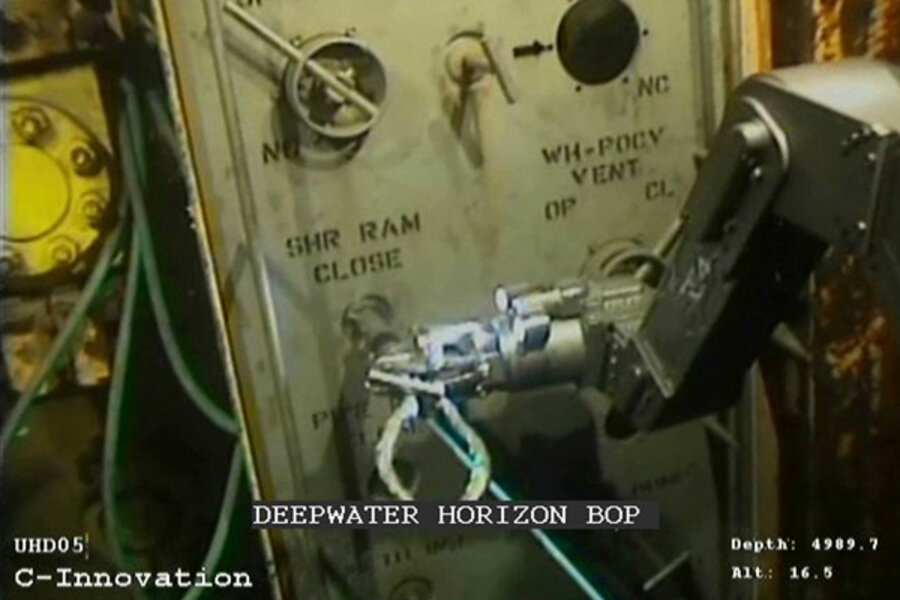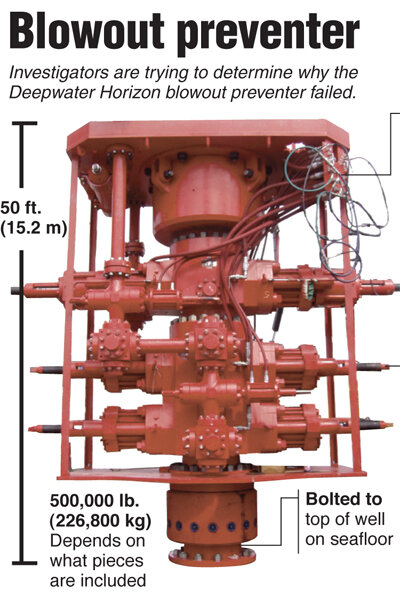Studies suggest MMS knew blowout preventers had 'critical' flaws
Loading...
The federal agency charged with setting safety standards for offshore oil exploration failed to act on at least four warnings about vulnerabilities in subsea blowout preventers, the critical safety device that failed to shut down the Gulf oil spill when the Deepwater Horizon oil rig exploded April 20.
Each of those four design flaws – detailed in three studies conducted for the US Minerals Management Service (MMS) during the past decade – threatened the ability of blowout preventers in deep water to function in an emergency.
Yet the flaws did not result in federal safety alerts or tougher standards for blowout preventer (BOP) manufacturers, say experts familiar with the MMS response to such findings.
RELATED: Before BP oil spill, Big Oil-led study urged feds to cut safety testing
With investigators still seeking to determine the cause of the Deepwater Horizon explosion, it remains unclear whether any of these vulnerabilities played a role in the failures that led to the Gulf oil spill. But MMS’s lack of action in spite of warnings about the flaws, three of which have not been previously reported, points to a long pattern of ignoring rather than fixing known safety threats, the experts say.
“Were BOPs designed to fail and did MMS know this? Yes, some of their key people knew,” says Robert Bea, an engineer at the University of California, Berkeley and one of the expert reviewers of President Obama’s 30-day offshore oil-exploration safety review. “Did BP know?” he adds. “Yes, some of their key people knew. Did the industry know? Yes, some of their key people knew.”
So what exactly did the MMS and industry officials know about the BOPs’ vulnerabilities and when? Government and industry officials have said the Deepwater Horizon disaster was unforeseeable – that BOPs were previously regarded as a virtually infallible “last line of defense” against a catastrophic blowout in deep water.
But a deeper look into three engineering studies from 2004, 2006, and 2009 commissioned by MMS – or done with MMS participation – tells a different story. The 2009 study, for instance, identifies 62 instances of BOP failures, four of which were deemed “safety critical.” The study was a joint industry-MMS venture and included the participation of at least four senior MMS officials. Each study sounded warnings about BOP vulnerabilities that, if heeded, could have given the agency years to fix them.
Officials at West Engineering Service, the consulting company and BOP specialist that conducted all three of the studies referenced in this article, did not return e-mails or phone calls. MMS officials, along with the Department of Interior, responded to e-mailed questions but refused requests for an interview.
“We are looking at everything, from what happened on the rig that night and the equipment that was being used, to the safety, testing, and backup procedures that are in place for that equipment,” Kendra Barkoff, Interior Department press secretary, wrote in an e-mail. “It’s also clear that we need a stronger oversight and enforcement agency to police the industry.”
The four design flaws highlighted by the three studies are as follows. The first three have not been previously reported.
No. 1: deep water pressure
In the fall of 2006, West Engineering Services of Brookshire, Texas, turned over to MMS officials a study on the effects of pressure on BOPs. Among its key findings: High deep-water pressure could severely damage the critical gaskets and seals on BOPs’ hydraulic ram valves, causing them to leak and fail in an emergency.
One type of hydraulic ram valve, called a shear ram, is designed to prevent a situation like the one in the Gulf. In the event of a catastrophic failure, the shear rams are supposed to stop the flow of oil by cutting and crumpling the pipe between them. The Deepwater Horizon’s shear rams failed, though it’s not yet clear why.
Many BOP gaskets (the Deepwater Horizon’s included) are designed to handle up to 15,000 pounds per square inch (psi) of internal pressure – the pressure of the oil and natural gas pressing outward on the BOP. But they are not mandated to handle external water pressure, which can equal more than 2,000 psi in deep water.
Moreover, stress on seals and gaskets could be exacerbated if the pressure inside the well drops dramatically, meaning pressure is higher outside than inside.
The study noted that neither the MMS nor the American Petroleum Institute (API) had any specific standards dictating how much external pressure the seals and gaskets must be able to withstand.
“The maximum allowable external pressure is never published and indeed may not even be known by the manufacturer,” the report said. “If differential pressure is applied to a component not designed to withstand it, there could be serious consequences for well control; the deeper the water the greater the risk....”
A BOP engineer active in the industry who asked not to be named corroborates the study’s findings: “It was gaskets and seals that were the challenge.”
The study recommended that the industry have an external-pressure test for closure mechanisms. That “would demonstrate a factor of safety in this critical area,” it said.
Some manufacturers have upgraded seals and gaskets voluntarily. “Manufacturers don’t sit around waiting for the MMS to write a spec,” says the BOP expert who requested anonymity. “If they waited for specs from MMS, they would still be waiting.”
But the lack of specific federal standards resulted in a lack of uniformity both in seal quality as well as their maintenance, say Dr. Bea and others.
Minerals Management Service officials said by e-mail that the agency’s safety research division did act on the 2006 report by sharing it with headquarters staff charged with writing regulations, with regional field staff who enforce the regulations, and with industry organizations. Technical papers were presented at conferences with the findings.
But almost four years after the study findings, there are no federal or industry external water pressure standards for BOP closure device seals and gaskets. “We have not updated our regulations related to these findings since the 2006 report,” an MMS official wrote in an e-mail.
No. 2: test ram vulnerability
Test rams are a relatively new innovation in the offshore oil and gas industry and are currently on only a few deep water drill rigs’ BOPs. They are designed to streamline costly and time-consuming hydraulic test procedures required under federal regulations. The Deepwater Horizon was one of the few rigs whose BOP had a test ram. One big problem: The devices don’t help in an emergency – and they may obscure emerging dangers.
That is precisely what happened in one of the “safety critical” failures recorded in the 2009 report. One of the BOPs studied experienced a critical failure when a leak developed at the wellhead connector, compromising its ability to maintain the correct pressure. “On rigs with test rams, the leak, regardless of size, would not have been identified,” the report noted.
The report strongly criticized test rams because they obscured leaks and took up space on a BOP that otherwise could have been used for a real ram.
Critics in Congress said the test ram retrofitted onto the Deepwater Horizon impaired the BOP’s redundancy and, therefore, reliability of the BOP.
The MMS responds that its “drilling engineers have allowed the use of test rams only after a very thorough review.”
No. 3: no safety alert
The 2009 study recommended a “safety alert” concerning the threat of failure of a BOP valve called an annular. Annular valves are like a large doughnut made of rubber and steel that can be mashed into the pipe to seal a well. The study recommended an alert that would derate – or lower – the estimate of how much pressure the annulars could handle when special large-bore drill pipe was being used.
“Failures have occurred while using this drill pipe size with standard [annular] elements,” the study found.
No such alert was ever issued, the MMS confirmed in e-mailed comments. The 2009 study “is not an MMS study” and therefore its “proprietary” data never became part of the agency’s safety research program data, the MMS wrote.
But the study itself and the prospectus for it refer to a partnership between MMS and 17 oil companies and other industry groups. The study and other documents related to it also reference four senior MMS officials who participated in the report.
No. 4: failure to cut pipe
The 2004 study for MMS suggested that changes in industry practices made shear rams increasingly prone to failure in deep water, a finding first reported by The Wall Street Journal. Among the problematic changes: higher well-bore pressures and greater drill pipe thickness.
Only 3 of 14 newer deep-water drilling rigs were found able to shear pipe at their maximum rated water depths, the study found. Not only that, only half of those rigs' operators required a shear-ram test during commissioning or acceptance. “This grim snapshot illustrates the lack of preparedness in the industry to shear and seal a well with the last line of defense against a blowout,” the study said.
Moreover, the industry was increasingly compounding the problem by using thicker, harder-to-cut pipes in deeper water. The shear rams could also fail if a thicker “tool joint” in the drilling pipe was between the rams when a disaster stuck.
In an e-mail, MMS writes that it did have a 2003 regulatory requirement that required rig operators to file data that show shear rams “are capable of shearing the drill pipe in the hole under maximum anticipated surface pressures.”
But even after the more comprehensive 2004 study, the MMS did not issue safety alerts or require specific new requirements for shear ram design to ensure they were powerful enough to cut the thickest pipe.
Oversight questions
All this raises the question: How tough should federal regulators be?
During the past decade, MMS’s approach has been to set a performance goal but not to dictate any specific requirements or regulatory standards.
But the president’s 30-day safety review of offshore drilling offers a laundry list of measures that will likely lead to tougher requirements, experts say.
At a New Orleans hearing last month, Michael Saucier, MMS field-operations supervisor in the Gulf, testified to federal investigators that the agency did not ensure that BP had proof that shear rams on Deepwater Horizon would work. But the agency had “highly encouraged” companies to have backup systems to trigger blowout preventers in an emergency, he said.
“Highly encourage?” US Coast Guard Capt. Hung Nguyen, asked. “How does that translate to enforcement?”
“There is no enforcement,” Mr. Saucier answered.
Related:






